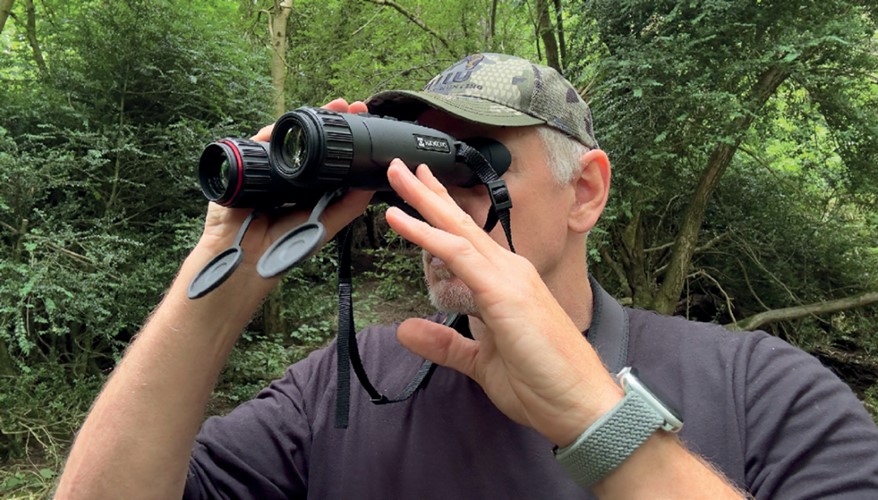Paul Austin has a long hard look at an affordable take on Hikmicro’s multispectral binoculars. Deer stalkers take note!
I was in the process of putting the finishing touches to my recent Habrok HQ35L review when was very surprised to spot yet another variant of the Habrok entering the fray. The ‘4K’ bit sounded intriguing, but I was puzzled as to why Hik were following up their latest release so closely with another multispectral gadget? Admittedly Hik don’t exactly hang around when it comes to product launches, but this seemed a bit premature even for them.
After a bit of digging, the penny dropped. Although virtually identical to its bigger brother at first glance, the Habrok 4K is a very different animal and targeted almost exclusively at the deer-stalking market.
So what’s the difference, other than the latest incarnation being less than half the price of its bigger brother? The only real physical difference is a 25mm thermal lens rather than the 35mm of the HQ35L. It’s under the bonnet where the real differences lie.
The big change is the thermal sensor, which without doubt accounts for the extra cost of the HQ35L The new variant has a higher NETD of <35mK, as opposed to the <20mK of the original. However, the Habrok 4K only offers a 256x192 sensor, which is very small compared with the 640x512 of the high-end offering. It’s even smaller than the average 384x288, which many would consider to be an entry-level thermal.
IN THE FIELD
What does that mean in the field? The thermal on the HE25L is all about detection, not identification. The workflow with the unit is all about spotting ‘something’ with the thermal and then switching to an optical channel to confirm exactly what you’re looking at.
With something like a deer, identification may not be an issue, but for analysing the condition and sex of an animal you’ll definitely need the optical channels. For a deer stalker especially, this isn’t a bad compromise. You get the basics in terms of thermal detection combined with an excellent daytime image, IR functionality with a built-in illuminator for way beyond first-light/last-light identification, plus LRF to confirm the distance to your quarry.
For anyone who spends time in the yard ratting or perhaps rabbiting in the fields with an air rifle or rimfire, it has real potential. Spot it with the thermal and then flip to IR mode once you’ve found a potential target.
A few years back a combination of low-res thermal, IR (courtesy of the built-in illuminator), daytime optical plus LRF would have been a game changer. And at the very reasonable price of this kit could remain so for anyone who’s not too concerned about thermal image quality.
Would it work for a foxer looking to save a thousand pounds plus on the price of the Habrok HQ35L? Not really.
For essentially static targets like rabbits and deer it’s fine, and for closer range ratting, IDing with the thermal alone would still work.
However, for foxers it’s a completely different story.
As any fox shooter will tell you, opportunities are often fleeting, and more often than not there simply isn’t time to be switching modes and faffing about. You need to confidently ID the target with the thermal and then get on the gun as quickly as possible before the opportunity passes you by.
The strength of HE25L’s big brother is that it offers you that ability.
Occasionally you’ll come across a static fox at extended range or perhaps one sitting at a weird angle, and the thermal won’t help much regardless of the resolution. Often, it’s the gait and outline of the animal in motion that gives the game away, and that’s where a higher-res thermal comes into its own.
However, very little of that applies to deer. They’re much larger for a start, often static and almost impossible to misidentify unless they’re in deep cover, in which case IDing with a thermal alone is often impossible. It’s here that the optical channels are needed. In terms of image quality, the daytime channel is excellent for a pair of what are digital binos. The same is true for the IR with its built-in illuminator. The illuminator is actually aligned better on this new model than on its predecessor and once again the on-board NV combo is truly excellent.
The only thing I would have like to have seen in the optical channels would be some form of image stabilisation. At high mag the image, especially in the daytime channel, is quite jumpy. This is an expensive feature to implement, which may account for its omission.
THE BOTTOM LINE
For a technologically savvy and financially astute deer stalker these binoculars are a very useful and affordable tool – perhaps less so for a shooting generalist. Nevertheless I’m sure that the HE25Ls will be found in the kit bags of many ratting enthusiasts and bunny bashers in addition to its primary audience in the deer-stalking market.
In terms of ergonomics and features, it’s basically identical to its predecessor and I have no complaints in that regard whatsoever. Video recording (with audio), screen sharing via Hik’s Sight App, separate focus for optical and thermal channels, great design, easy navigation, and tons of features to play with alongside excellent optical image quality and last-light performance. And let’s not forget the LRF.

TECH SPECS
- Multispectral thermal binoculars, day colour, night vision and LRF
- 256×192 resolution @12μm thermal detector
- Thermal module NETD <35mK (@25°C, f1.0)
- 25mm, f1.0 lens
- 3840x2160 4K ultra CMOS detector
- 60mm, f2.2 digital lens with 5.5x to 22x digital zoom
- 1920x1080 resolution 0.49" OLED display
- 795g, with a compact and ergonomic design
- Built-in 850nm IR illuminator and laser rangefinder with 1000m measuring distance
Scott Country International www.scottcountry. co.uk